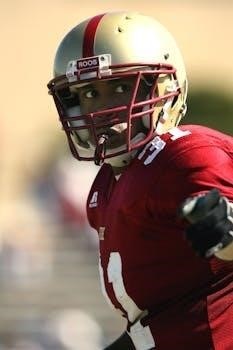pokemon gold strategy guide pdf
Pokémon Gold, a classic Game Boy Color title, presents a fresh journey through the Johto region. This adventure features new Pokémon, characters, and challenges, differentiating itself from previous series entries. Players embark on a quest to become the best trainer.
Overview of the Johto Region
The Johto region, the setting for Pokémon Gold, is a land steeped in tradition and natural beauty, offering a diverse landscape for trainers to explore. This region is known for its historical sites, unique geographical features, and a blend of old and new. Johto features varied terrains including forests, mountains, and coastal areas, each home to different species of Pokémon. The region’s towns and cities often reflect a blend of traditional Japanese architecture and modern influences, creating a unique atmosphere. Players will travel through various routes, encountering both familiar and never-before-seen Pokémon, making it an engaging and captivating experience. This region provides the backdrop for an all new adventure.
Starting Your Journey
Your adventure in Pokémon Gold begins in New Bark Town, where you’ll make crucial early decisions. These choices shape your path as you set out to become a top trainer.

Choosing Your Starter Pokemon
Professor Elm presents you with three starter Pokémon, each with unique strengths. Chikorita, a Grass-type, is a sturdy choice for beginners, offering good defense and support moves. Cyndaquil, a Fire-type, is known for its offensive prowess, dealing significant damage with its fire attacks. Totodile, a Water-type, provides a balanced approach, combining offense and decent bulk. Your starter selection is crucial as it influences your early game strategy, shaping the team you build. Consider your play style and what challenges you anticipate before making this key decision. Think about how your starter will match up against the early gym leaders, as well as the types of Pokémon you hope to catch along the way, because the early game will heavily depend on your pick. It can impact your early battles and the overall gameplay experience.
New Bark Town and Professor Elm
Your journey in Pokémon Gold begins in the peaceful New Bark Town, home to Professor Elm’s research lab. Professor Elm, a renowned Pokémon researcher, is your guide and mentor at the start of your adventure. He entrusts you with a vital task, sending you on a mission to collect information about Pokémon. This initial quest leads you to choose your first Pokémon, setting your journey in motion. New Bark Town serves as your starting point, filled with friendly locals who provide valuable hints and assistance. Professor Elm’s lab is a hub of learning, where you’ll receive essential guidance and items to aid you on your quest. He is responsible for your introduction to the world of Pokémon, and it is because of him that you will embark on this adventure. Always be sure to check in with him from time to time.
Navigating Johto
Exploring Johto involves traversing diverse routes, encountering various Pokémon and trainers. Key locations like cities and towers offer unique challenges and opportunities for growth. The region is rich with hidden secrets.
Early Routes and Encounters (Route 29-31)
The initial routes, specifically 29 through 31, serve as the starting point for your Pokémon journey. Route 29 is the first area where you can begin catching Pokémon, with common encounters such as Pidgey, which appears during the day, and Sentret, the obligatory rodent of the area. As night falls, Hoothoot replaces these daytime Pokémon. These early routes introduce players to the basics of wild Pokémon battles and capture mechanics. Route 30 and 31 are slightly more challenging with encounters with Pokemon like Caterpie, Weedle and other bug types, leading to more strategic battles. Exploring every patch of grass is important to ensure that you encounter new Pokémon and gain experience points for your team. These areas are essential for building your team and understanding the initial exploration aspects of Johto. Trainers will also be encountered on this route, testing your skills.

Key Locations⁚ Violet City and Sprout Tower
Violet City is an early but significant location, housing the first Gym and Sprout Tower, a unique training area. The Sprout Tower, a tall pagoda-like structure, is inhabited by monks and numerous Bellsprout, offering trainers a chance to gain experience battling these Grass-type Pokémon. This location introduces you to the concept of mini-dungeons and provides a good opportunity to level up your team. Reaching the top of the tower allows you to get a free HM05 Flash. Violet City also serves as a hub where players can purchase essential items and prepare for the upcoming gym battle. The gym is a test of your team’s strength, and the tower helps to train your team for it. Both locations, are critical to understanding the early gameplay dynamics in Pokémon Gold and provide valuable experience.
Gym Battles and Badges
Gym battles are a core component of Pokémon Gold, requiring trainers to defeat Gym Leaders to earn badges. Each badge signifies progress and allows access to new areas, showcasing a trainer’s prowess.

Gym Leader Strategies
Confronting the Gym Leaders in Pokémon Gold demands strategic team building and type matchups. Falkner, the first Gym Leader, specializes in Flying-type Pokémon, making Rock or Electric types advantageous. Bugsy, the second Gym Leader, uses Bug-types, vulnerable to Fire and Flying moves. Whitney’s Normal-type lineup, including her infamous Miltank, can be challenging, requiring strategic use of Fighting types and status moves. Morty’s Ghost-type Pokémon are susceptible to Dark and Ghost attacks. Chuck’s Fighting-type team requires Flying or Psychic Pokémon. Jasmine’s Steel-types are weak to Fire, Fighting, and Ground. Pryce’s Ice-types fall to Fire, Rock, Fighting, and Steel moves. Finally, Clair’s Dragon-types need Ice or Dragon attacks. Understanding these weaknesses is crucial for success.

Legendary Pokemon and Events
Pokémon Gold features encounters with legendary Pokémon like the three beasts and the game’s mascot. Special events include unique in-game occurrences that offer rare items and Pokémon encounters.
The Three Legendary Beasts
In Pokémon Gold, the three legendary beasts, Raikou, Entei, and Suicune, roam the Johto region after being awakened. These powerful Pokémon are not found in fixed locations, making them challenging to encounter and capture. Their appearances are random, requiring the player to move between different areas and routes to have a chance of finding them. Each beast has unique characteristics and weaknesses, demanding diverse strategies for successful capture. Players should be prepared with strong Pokémon, status inflicting moves, and plenty of Poké Balls to increase their chances of success. Tracking them down is a significant part of the post-game experience, adding a layer of difficulty and excitement.
Special Events and Encounters
Pokémon Gold features a variety of special events and unique encounters beyond the main storyline. These include opportunities to obtain rare Pokémon, access hidden areas, and engage in battles with special trainers. One notable event is the encounter with the legendary Pokémon Lugia, which requires specific actions and preparation to trigger. Other events might involve specific time-based occurrences or require the player to revisit previously explored areas after certain milestones have been achieved. These special events provide players with additional challenges, rewards, and opportunities to expand their Pokédex. Exploring every nook and cranny of the Johto region and interacting with all NPCs is crucial to uncovering these secrets. Some events are also tied to in-game time, encouraging players to explore at different times of the day or night.
Post-Game Content
After defeating the Elite Four, Pokémon Gold offers substantial post-game content, including exploring the Kanto region. Completing the Pokédex and facing new challenges extend the adventure. This allows for even more gameplay.
Exploring Kanto Region
Following your triumph over the Johto League, a remarkable post-game experience awaits⁚ the chance to journey through the Kanto region, the setting of the original Pokémon games. This is not merely a repeat of old adventures; Kanto is presented with changes and new challenges. You will revisit familiar towns and routes, experiencing them with a new perspective and a stronger team of Pokémon. Gym Leaders, though they retain their expertise, have significantly stronger teams, requiring you to adapt your strategies. This trip to Kanto adds a substantial amount of playtime, offering a nostalgic yet challenging experience for the trainers. Exploring Kanto also unlocks new areas and opportunities to catch unique Pokémon not found in Johto.
Completing the Pokedex
A core objective in Pokémon Gold is to complete the Pokédex, a comprehensive record of all Pokémon discovered. This task is significantly expanded in the second generation, with over 100 new Pokémon to find. Completing the Pokédex requires more than just battling; it involves exploration, trading, and even breeding. Some Pokémon are exclusive to either the Gold or Silver versions, necessitating trading with other players. Certain Pokémon are only found in specific locations or at particular times of the day, adding an element of discovery. Breeding mechanics also allow for obtaining Pokémon that would otherwise be unobtainable, adding another layer of complexity. Successfully completing the Pokédex is a significant accomplishment, showcasing your mastery of the game and your dedication to catching them all.


